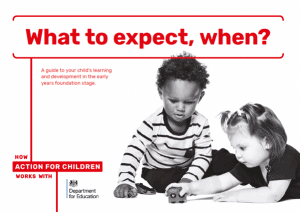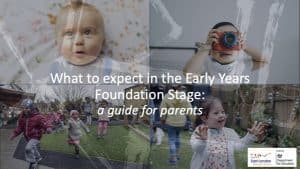An Interview with Fliss James, the project lead of ‘What to expect in the Early Years Foundation Stage: a guide for parents.’
by Caroline Vollans on November 2
7 min read:
Practitioners will be familiar with What to expect, when? This booklet went with the 2012 version of Development Matters. It helped parents find out more about how their children learn and develop during their first five years, in relation to the EYFS.
What to expect, when? has been replaced with a new document, What to expect in the Early Years Foundation Stage: a guide for parents (2021).
Fliss James, the project lead, is keen to recognise the importance of the previous document. She comments, ‘What to expect, when? was an invaluable source of information for parents, childminders, early years educators and schools across the country. It has been important to acknowledge this success and legacy by retaining key features of the guide: written from the perspective of the child with ideas and tips as to how parents can help their child’s learning and development.
However, there are some important and timely changes to the format and content of the new document. Dr Julian Grenier, who worked with Fliss on the new guide, highlights some key differences to these. ‘First of all, few people want a PDF to print out anymore. Parents have told us repeatedly that they want content which is easy to read on a mobile phone or tablet. So, we made the document a shorter and quicker read for parents, scaled so it can be easily read on a small screen.’
‘Secondly, the revised EYFS moves away from the focus on tracking children’s development using age bands. So, it made sense to evolve away from the idea of guiding parents about what to expect, and when to expect it. The new document states that “children develop and learn at different rates and in different ways. Their development is not neat and orderly!” It’s intended as a guide to the sort of learning children will be involved in when they’re in an EYFS setting, and how parents can get involved and support their children’s learning.’
Though there were probably several, what would you say was the main challenge you encountered?
We had a short timescale in which to establish an expert steering group and consult with parents and families. This was a huge challenge, particularly given the constraints and logistics in terms of meeting face to face. However, the Expert Group came together on Zoom and worked really well to support the development of the new guide. As a frontline early years teacher at Sheringham Nursery School and Children’s Centre, I was able to meet parents regularly and discuss ideas and show early drafts to get their feedback. We were also able to build the work on the many years of experience that Sheringham has of working in close partnership with parents.
And, similarly, what was the main enjoyable aspect?
The opportunity to learn from the expert group was invaluable. Designing the guide and thinking carefully about the choice of images was enjoyable.
What would you say was ground-breaking about the original ‘What to expect, when?’; how did you build on it?
The original guide written by the team at 4 Children was written from the perspective of the child. It centred the child and focused parents and families on the child’s needs and development. It didn’t focus on telling parents what they should do. It was important to build on this and keep this at the heart of the document.
What are the 3 most significant changes?
- A focus on empowering parents and families to understand the message that what happens early matters for a lifetime. The document explains in straightforward language how powerful those early, loving, responsive interactions are for brain development. It gives parents an overview of the research. It suggests simple yet meaningful ways of encouraging parents to talk and play more with their young children from the earliest moments.
The document also has some clear messages about the vital role of parents and families in shaping their children’s views of the world. With support, guidance and constructive feedback from the expert group we thought carefully about how to share core messages about developing anti-racist attitudes, the impact of gender stereotypes and the importance of physical activity.
The document highlights the power of fostering and celebrating home languages.
We hope that by providing this information, we can support parents and families to have an awareness of their own attitudes and views and enable every unique child and family to have a sense of belonging.
- The overall design is a significant change – it’s much more visual, with a lot more photos and graphics. We’ve also included links to research, videos and practical activities for parents who want to find out more.
- The new guide includes the Characteristics of Effective Teaching and Learning – we think that sharing information with parents about how children learn is just as important as information about what they will be learning in the EYFS. We’ve also included observational checkpoints from Development Matters (2020).
We want parents to have access to the same information that practitioners have. That way, parents can have the key information at hand when they’re talking with their child’s key person or childminder. The document makes it clear that this partnership is a two-way process: practitioners can use the document to explain what children are learning in the EYFS, and can also use it as a focus for listening to parents.
Who did you collaborate and consult with?
A steering group of practitioners, academics and consultants from across the sector as well as guidance from Sue Robb OBE, who led on the development of the original version.
How does ‘What to Expect in the EYFS’ build on the research and evidence into parental support for children’s learning? For example, Hungry Little Minds and the EEF Guidance report.
The guide builds on the rigorous evidence base of the Hungry Little Minds campaign and highlights the core message of ‘Chat, play, read’ throughout. Sheringham was closely involved in the development of the EEF Guidance Report on Working with parents to improve children’s learning. Much of what the team learnt from that work is reflected in the new guide, for example the power of using technology like phones and tablets rather than relying on print outs and newsletters.
We also considered the findings of the Royal Foundation’s 5 Big Questions which identified the ‘need for improved translation and increased accessibility of scientific research to parents.
How will this document enhance the necessary collaboration between parents and EYFS practitioners to support each child’s learning and development?
We know from research that the home learning environment has a significant impact on children’s early learning and development – what parents do is more important than who parents are. This guide provides early years practitioners with crucial evidence-based information that will enable them to have meaningful conversations with parents about how they can effectively support their child’s learning and development in fun and playful ways at home. As with the previous version, the guide enables early years practitioners to support parents’ knowledge and understanding of how their child is learning and developing in relation to the seven areas of learning and development and the Development Matters guidance.
We recommend that practitioners use the guide as a focus for conversations with parents. As well as sharing the link, it’s useful when you’re having an update meeting with a parent to focus on one or two aspects of the guide. That informed dialogue about children’s learning matters more than anything.
What do you think will be most welcomed by parents?
We used information from the biggest-ever research project involving parents of children in the early years, the Royal Foundation’s report following their ‘5 Big Questions’ survey. We also consulted regularly with parents of young children directly. What we learnt from both these sources makes us confident that parents will welcome the accessible information about early brain development and interactions from birth, with a focus on the conception to three period. We hope the links to short videos will be an enjoyable new feature that will help parents to reflect on their child’s development and learning. During the consultation, one parent commented: “I love photos …I think I just take notice of the information more, some drawings, pictures can look a bit general. Like if I saw this in the doctors or something, I would be really interested, the photos of children and families make it real.”
With so many thanks to Fliss for agreeing to this interview. It was a great pleasure to speak with someone so unreservedly hard working and committed to doing her best for young children and their families.

